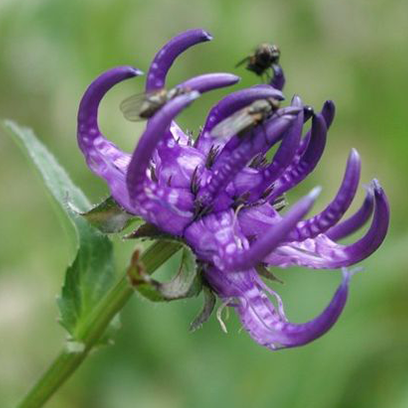DEVIL’S CLAW
Devil’s claw was introduced to Europe in the early 1900s, where the dried roots have been used to restore appetite, relieve heartburn, and reduce pain and inflammation. Today, devil’s claw is used widely in Germany and France to fight inflammation or relieve arthritis pain, headache, and low back pain.
Native to southern Africa, devil’s claw (Harpagophytum procumbens) gets its name from the tiny hooks that cover its fruit. Historically, devil’s claw has been used to treat pain, liver and kidney problems, fever, and malaria. It has also been used in ointments to heal sores, boils, and other skin problems. Devil’s claw does not have an odor, but it contains substances that make it taste bitter. It is a leafy perennial with branching roots and shoots. It has secondary roots, called tubers, which grow out of the main roots. The roots and tubers are used as medicine. Several studies show that taking devil’s claw for 8 to 12 weeks can reduce pain and improve physical functioning in people with osteoarthritis.
One 4-month study of 122 people with knee and hip osteoarthritis compared devil’s claw and a leading European medication for pain relief. The people who took devil’s claw had as much pain relief as the people who took the medication. Those who took devil’s claw had fewer side effects and needed fewer pain relievers throughout the study.
An analysis of 14 studies using devil’s claw to treat arthritis found that higher quality studies showed devil’s claw may relieve joint pain. And a review of 12 studies using devil’s claw for treating arthritis or low back pain found that devil’s claw was at least moderately effective for arthritis of the spine, hip, and knee. Preliminary evidence suggests that devil’s claw may help relieve neck and low back pain. In a small study of 63 people with mild-to-moderate back, neck, or shoulder pain, taking a standardized extract of devil’s claw for 4 weeks provided moderate relief from muscle pain. In a larger study of 197 men and women with chronic low back pain, those who took devil’s claw every day for a month said they had less pain and needed fewer painkillers than those who took placebo.
A 54-week study compared 38 people who took devil’s claw with 35 people who took the pain reliever rofecoxib (Vioxx). For these people, devil’s claw worked as well as Vioxx to relieve pain. The Food and Drug Administration (FDA) took Vioxx off the market because it increases the risk of heart problems.
Devil’s claw contains iridoid glycosides, components believed to have strong anti-inflammatory effects. It has a high concentration of one type of iridoid, called harpagoside, and some laboratory tests suggest it may relieve pain and inflammation.
(Source: Mount Sinai Hospital)
Used in: Pinelli Flexi Project™
READ SCIENTIFIC PUBLICATIONS ON
- Devil’s Claw (Harpagophytum procumbens) as a Treatment for Osteoarthritis: A Review of Efficacy and Safety
- Devil’s Claw—A review of the ethnobotany, phytochemistry and biological activity of Harpagophytum procumbens
- Flavocoxid is as effective as naproxen for managing the signs and symptoms of osteoarthritis of the knee in humans: a short-term randomized, double-blind pilot study
- Molecular Targets of the Antiinflammatory Harpagophytum procumbens (Devil’s claw): Inhibition of TNFα and COX-2 Gene Expression by Preventing Activation of AP-1
- The Fight against Infection and Pain: Devil’s Claw (Harpagophytum procumbens) a Rich Source of Anti-Inflammatory Activity: 2011–2022
- From Bush Medicine to Modern Phytopharmaceutical: A Bibliographic Review of Devil’s Claw (Harpagophytum spp.)
- The Efficacy of Harpagophytum procumbens (Teltonal) in Patients with Knee Osteoarthritis: A Randomized Active-Controlled Clinical Trial
- Treatment of patients with arthrosis of hip or knee with an aqueous extract of Devil’s Claw (Harpagophytum procumbens DC.)

